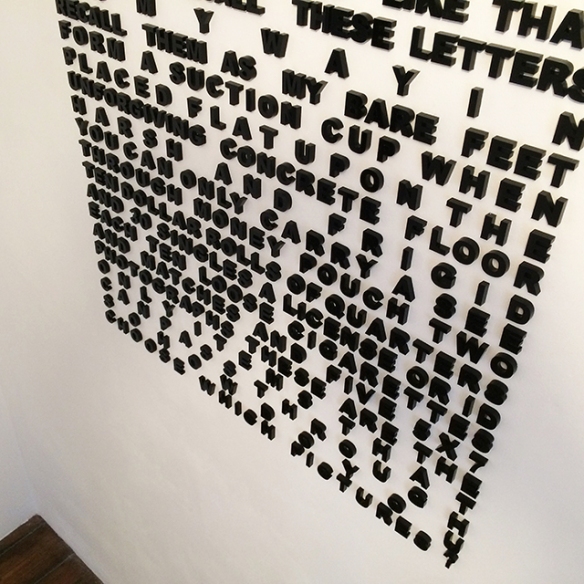Like last week, this Gallery-Run-write-up has been reduced to the individual photo captions, shown further down the page, in order to make room for a temporary project called Plus 1 that now follows. Guests join me, hopefully, on a gallery run and will share ideas. Alas there are still no takers, though admittedly I still haven’t really asked anyone else yet, beyond the hopeful invitations shown last week. This week’s article features something entirely different, though still comprising a sort of plus 1, whilst also verging on the confessional! For two months I learnt the names of artists associated with London-Frieze-exhibiting galleries, from lists of paper whilst out jogging being careful not to run into lampposts or pedestrians. Each list could be hand-held and studied. Some even show the effects of rain or of being stuffed into a pocket. Along with a two word summary of something that each artist did, the process helped to create a stack of memory boxes that follows the sequence of the numbered lists shown in the photograph below. The memory boxes automatically bring forth the next in the stack, provided they are cycled through in recall about once every fortnight. The boxes also bring with them an essence of each artist, since they have gradually filled up with experiences of gallery visits. Memory is a strange thing and this sequential recall is probably born through the need to piece together consecutive events in time, something the philosopher David Hume considered to be the rather unphilosophical survival function that shapes the human brain.
 The Lists Cycle. Gallery Runner lists in the foreground.
The Lists Cycle. Gallery Runner lists in the foreground.

Pablo Bronstein of Herald Street Gallery with a film that crosses the glam game show format with some of the grand narratives of Greek mythology.

Bernard Cohen at Flowers Gallery.

Elizabeth Murray of Pace Gallery showing at Victoria Miro with what looks like biological imagery on the shaped canvas.

Joan Mitchell at Victoria Miro in a group show.

Carlos Garaicoa at Parasol Unit with reconstructions of tiled Cuban adverts, albeit with a few alterations.

Fab boat in Camden.

Ryan Gander of Lisson Gallery with carved shapes from an important mathematical blueprint. Meanwhile the black pile of sand steadily grows during the show from a thin stream of sand falling out of a hole in the ceiling.

Pedro Reyes of Lisson Gallery with a room full of sculpture and wall tableaux forming a complete system of ideas, some executed and some pending.

Ian Cheng of Pilar Corrias showing at Serpentine Galleries. We see what appears to be a simple animation but gradually learn that the creature is living in real time and using a sort of AI to try things out and get used to its rather unusual body.


















